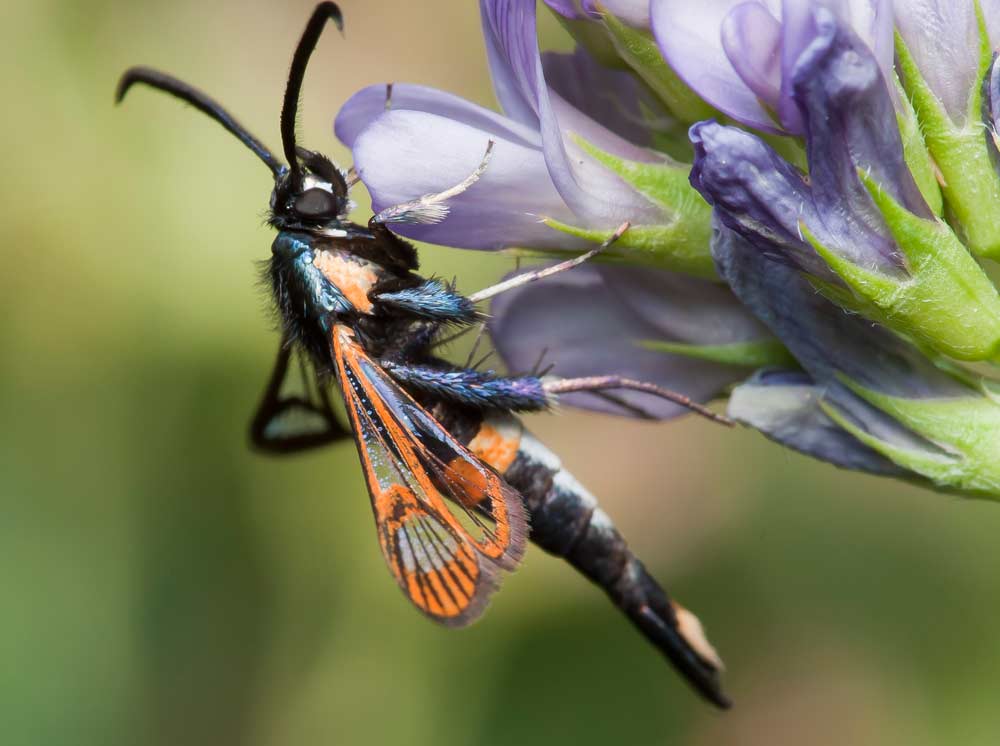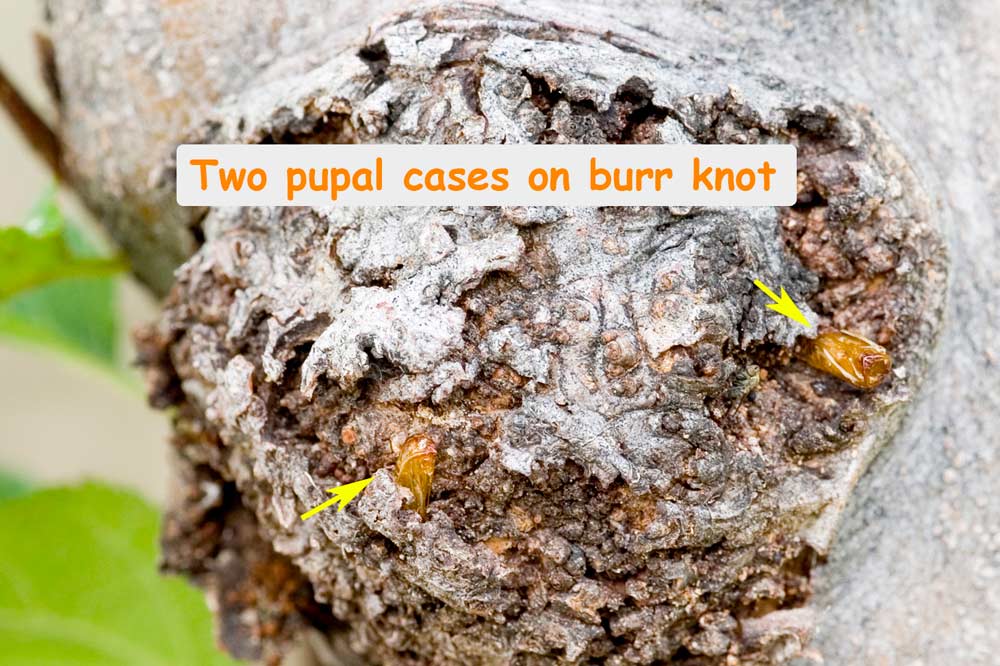
An adult male apple clearwing moth works a flower. (Courtesy Mark Gardiner)
An apple tree pest that thrives in the arid climate of British Columbia’s Okanagan Valley in Canada may be on its way over the border into Washington, if it hasn’t reached its southern neighbor already.
The apple clearwing moth, a relative of the peach tree borer, has been burrowing into the graft unions of young trees in British Columbia for more than a dozen years, starting in the Similkameen Valley and spreading throughout the region as far as Winfield, roughly 12 miles north of Kelowna.
“You do not want this thing, believe me,” said Brian Witzke, a Kelowna orchardist who discussed the moth in July with the participants of the International Fruit Tree Association’s summer tour.
The pest is believed to have originated in Europe and thrives in arid climates like Central Washington and interior British Columbia.
“It’s lethal in this area,” said Wilfred Mennell, an orchardist in the Similkameen Valley 70 miles south of Kelowna. He was among the first affected in British Columbia and believes it came with a shipment of rootstocks from Holland, where it’s a latent pest.
So far in Washington, the clearwing has not shown up near fruit orchards in state insect surveys, said Betsy Beers, a Washington State University entomologist. But growers can expect it sooner or later.
“We’ve been expecting it in Washington because of the proximity of the infestation in the Similkameen,” Beers said. “Insects do not understand international boundaries. Movement of pests can be relatively leisurely or at lightning speed. It depends on the species.”
The Washington State Department of Agriculture first trapped the clearwing in Whatcom County in 2008 on the west side of the state far from orchards. But traps in Washington’s Okanogan County, directly south of British Columbia’s growing region, have been empty, even this year, Beers said.
However, Gary Judd, a research entomologist with Agri-Food Canada in Summerland, is convinced it has reached Washington already. He has seen damage to trees near Oroville, just south of the border.
“Just how far south it’s gone, no one can say,” said Judd, who has partnered with U.S. entomologists on clearwing related projects.

Molly Thurston, left, from BC Tree Fruits, pulls a dead apple clearwing moth from a trap at Northview Orchards during the IFTA summer tour. (TJ Mullinax/Good Fruit Grower)
In Canada
Most orchards in the Similkameen and Okanagan valleys have some level of infestation by now, said Judd. The insect usually attacks trees older than three years on the trunks through an opening in the bark, especially in burr knots near graft unions. However, by now populations have reached a high enough density that the insect is attacking higher in the canopy at pruning scars, too, he said.
Entomologists are still working on a variety of sustainable, long-term control methods. Pheromone disruption has so far been unsuccessful, Judd said, because the day-flying bugs rely more on visual cues than they do on smell for mating. Traps using kairomones, scents emitted by flowers or fruit, certainly attracted both males and females, but researchers haven’t yet designed a trap the bugs will actually enter in great numbers.
“The insect is very smart,” Judd said.
Better traps and synthetic kairomones are the focus of Judd’s work now.
That leaves spraying as the main control method for the time being.
Though all entomologists suggest making sure growers have the right bug before spraying, Judd suggests they jump on the pest early, drenching their trunks with Rimon (novaluron) once in the spring or fall to get control for two years. Other growers use Altacor (chlorantraniliprole) or Delegate (spinetoram) in the summer, said Molly Thurston, a field representative with BC Tree Fruits, a packing cooperative in Kelowna. In both cases, the chemical must be targeted with booms or handheld sprayers directly at the graft unions on the trunks. All three chemicals are registered for apples and pears in the United States.
Unlike codling moth, the clearwing is under no areawide control mandate, causing frustration between neighbors at times, Thurston said.
“In the face of having so many invasive pests, a lot of growers don’t recognize the problem until they have tree death,” Thurston said. Spraying is so time consuming and expensive, growers feel forced to accept the tree loss as a cost of business.

Brian Witzke motions toward one of his blocks that’s been hit with apple clearwing moth during a tour of his Northview Orchards near Kelowna, British Columbia, during the July 2018 International Fruit Tree Association summer tour. The clearwing moth has been a damaging pest in British Columbia for more than 12 years. (TJ Mullinax/Good Fruit Grower)
In Kelowna, Witzke has neighbors like that, and they frustrate him.
“They will get convinced when they walk into a block like that one somewhere … and they’re going to find 2,000 dead trees,” he said.
Witzke uses Altacor on his trees at least twice a year, aiming his booms both high and low and angling them forward to hit the trunks at an angle. Then he repeats the procedure from the other direction. He sprays until the chemical runs down the trunk and creates small puddles. It’s a true drench.
“If I’m going to go after this thing, I’m going to go after it,” he said. •

Pupal cases protruding from a burr knot are one clue that the apple clearwing moth is causing damage in an apple orchard. (Courtesy Mark Gardiner)
What to look for
To detect the apple clearwing moth, entomologists suggest looking for damage in April and May when the pest leaves orange-brown frass that looks like sawdust on the bark around the larval feeding galleries, usually located near the graft union and sometimes at burr knots or pruning scars. The insect also leaves exuvia — a shed skin or pupal case — that can be seen protruding up to a half-inch from the bark during summer.
Feel the bark for sponginess and scrape it away from the cambium below to look for the feeding galleries and perhaps even the larvae. Also, hang pheromone traps to detect adults. Some growers also make their own traps using plastic soda bottles filled with a grape juice solution.
—by Ross Courtney






Leave A Comment